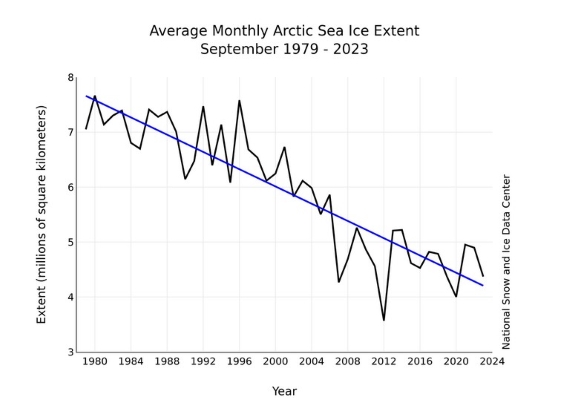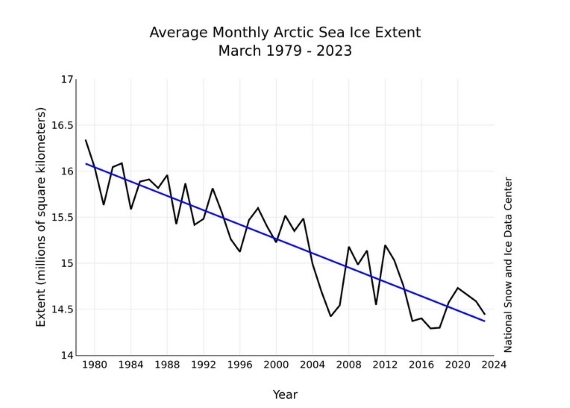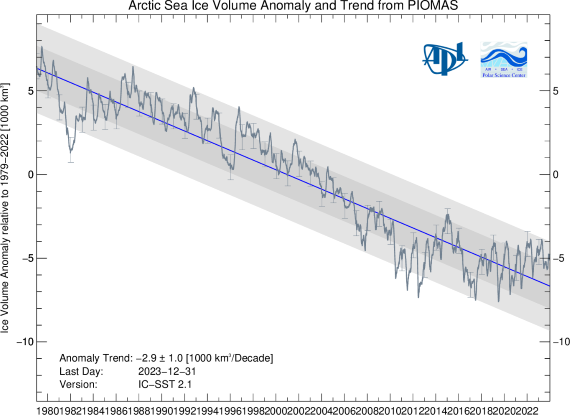Has Arctic sea ice returned to normal?
What the science says...
| Select a level... |
 Basic
Basic
|
 Intermediate
Intermediate
| |||
|
Thick arctic sea ice is in rapid retreat. |
|||||
Climate Myth...
Arctic sea ice has recovered
"Those who have been following NSIDC and JAXA sea ice plots have noted that this has been an extraordinary year so far, with Arctic sea ice hitting the “normal” line on some datasets. ...
As of today, JAXA shows that we have more ice than any time on this date for the past 8 years of Aqua satellite measurement for this AMSRE dataset." (Anthony Watts, 22 April 2010)
At a glance
One of the great metrics of climate change, because it is easy to visualise, is sea-ice in the Arctic. Every year, the ice margins retreat in the northern summer, reaching a minimum extent some time in September. It then refreezes through the long, dark cold winter months, until its maximum extent is reached in March.
Arctic sea-ice has a seasonal component - so-called 'first year ice' - and the more perennial 'multi-year ice'. First-year ice is relatively thin - 30-40 centimetres is typical. Multi-year stuff is thicker - 2-4 metres and much of it is situated between the north coast of Greenland and the North Pole.
Most of the annual, seasonal decline in ice extent, observed by satellites for more than 40 years, is due to first-year ice melting: the more robust multi-year ice takes more energy to remove, but nevertheless it is in decline, too. Calculations of sea-ice volume reveal that trend.
How does sea-ice form? We all know the freezing temperature of saltwater is lower than that of freshwater, hence the spreading of rock salt on the roads on frosty winter nights. Similarly, the ocean temperature needs to fall below -1.8°C (28.8°F) for sea-ice to form. In the freezing season it starts freezing over once the upper 150 metres or so of the ocean are close to that temperature.
Melt varies a lot from one year to another. This should come as no surprise: sea-ice, being on an ocean, moves about a fair amount. Variations in ocean-currents are particularly important since if sea-ice can be 'exported' out of the Arctic, it enters what is basically a hostile environment, where it melts away to nothing. Incidentally, such floes are a lot smaller than icebergs like the one that famously destroyed the Titanic in April 1912. Such ice behemoths originate where glaciers 'calve' upon reaching the sea.
Weather is a highly variable driver of sea-ice melt. Prolonged strong winds from the right direction can cause mass-export of ice into warmer waters. Then again, winds from the south transport warm air over the Arctic Ocean, causing the melting to intensify. But they may also bring in extensive cloud-decks, blocking a lot of incoming Solar energy. No surprise then that melt seasons vary a lot from one season to another.
As in most things related to climate change, it's the multidecadal trend that is key and that is unequivocally downwards, both in terms of extent and volume. Sudden spurts of growth are interesting, as are record meltdowns such as that in 2012. But that's it. Trend is the critical bit. The data clearly show that since 2010, when the statement in the box above originated, eight out of the ten lowest Arctic sea-ice minima have occurred. The only two melt-seasons outside of that time-frame were in 2007 and 2008. For the big picture regarding Arctic sea-ice, ignore the noise from one year to the next and look at all the data. It's heading one way - down.
Please use this form to provide feedback about this new "At a glance" section. Read a more technical version below or dig deeper via the tabs above!
Further details
Discussions about the amount of sea ice in the Arctic often confuse two very different measures of how much ice there is. One measure is sea-ice extent which, as the name implies, is a measure of coverage of the ocean where ice covers 15% or more of the surface. It is a two-dimensional measurement; extent does not tell us how thick the ice is. The other measure of Arctic ice, using all three dimensions, is volume, the measure of how much ice there really is.
Sea-ice consists of first-year ice, which is thin, and older ice that has survived one or more melt seasons, so that it has accumulated volume. This thicker multi-year ice is particularly important because it makes up most of the volume of the sea-ice. Volume is also the important measure when it comes to climate change, because it is the volume of the ice – the sheer amount of the stuff – that science is concerned about, rather than how much of the sea is covered in a thin layer of ice*.
Over time, sea ice reflects the fast-changing circumstances of weather. It is driven principally by changes in surface temperature, forming and melting according to the seasons, the winds, cloud cover and ocean currents. In 2010, for example, sea ice extent recovered dramatically in March, only to melt again by May.
Because sea-ice is subject to such powerful short-term effects, we cannot conclude anything about the health of the ice from just a single year’s data. It is over multiple decades that an obvious trend emerges. According to the National Snow and Ice Data Center, the overall trend in Arctic sea-ice minimum extent from 1979 to 2022 is down - by 12.6 percent per decade, relative to the 1981 to 2010 average (fig. 1). The average loss of sea ice works out at about 78,500 square kilometres per year. That's like losing an area the size of the state of South Carolina or the country of Austria - every year!


Fig. 1: Sea-ice extent in a) September, at the seasonal minimum (top panel) and b) March, at the annual maximum (bottom panel), for the period 1979-2023, . The trend is clear. Source: NSIDC
Multi-year ice volume is in steep decline. As you might imagine, thick ice takes a lot more heat to melt, so the fact that it is disappearing so fast is of great concern (fig. 2).
Fig. 2: Arctic sea-ice volume anomaly from PIOMAS. Daily sea-ice volume anomalies for each day, computed relative to the 1979 to 2022 average for that day of the year. Tick–marks on the time axis refer to the first day of each year. The trend for the period 1979- present is shown in blue. Shaded areas show one and two standard deviations from the trend. Error bars indicate the uncertainty of the monthly anomaly plotted once per year. Source: Polar Science Center, University of Washington.
It is clear from the various data sets, terrestrial and satellite, that both the sea ice extent and multi-year ice volume are reducing decade by decade. The full extent of annual ice reduction is seen in September of each year, at the end of the Arctic summer, and is on a long-term downward path. Multi-year ice volume has not recovered at all, and is showing a steeply negative multidecadal trend.
* Footnote: Although a thin layer of ice doesn’t tell us much about the overall state of ice loss at the Arctic, it does tell us a great deal about Albedo, the property of ice to reflect heat back into space. When the sea ice diminishes, more heat passes into the oceans. That heat melts the thick ice and speeds up the melting of thinner sea ice, which in turns allows more heat to accumulate in the oceans. This is an example of positive feedback.
Last updated on 4 February 2024 by John Mason. View Archives































 Arguments
Arguments





































No, No, everything's OK with Arctic ice (kidding). Steven Goddard has a plot on his site showing that recently, there was the "Most Ice Gain Ever Recorded". What the plot seems to show is sea ice area change from the summer minimum to the cold season maximum. If the summer minimum extent is in a general, pronounced, downward direction, but spring max ice extent is holding steady or decreasing much less slowly it seems maybe the plot could reflect reality. But of course he's misusing that reality to imply something that is not true: i.e there's no "problem", by only highlighting a fraction of the story and then counting on his readers lack of curiosity and predjudices to make the incorrect assumption that arctic is is just fine - instead of for example seeing that the graph would represent the replacement of multiyear-age ice with one year old ice, among other things. "Skeptics", sheesh.
The most recent PIOMAS current ice volume anomaly graphic (31 January 2013) suggests to me that the Arctic Ocean is beginning to behave much more like a seasonally frozen lake or pond than a permanently frozen large expanse of ocean that melts around the edges. Note in particular the annual pattern in the graphed data from the 2010 maximum to the end of January, 2013:
http://psc.apl.washington.edu/wordpress/wp-content/uploads/schweiger/ice_volume/BPIOMASIceVolumeAnomalyCurrentV2.png?%3C?php%20echo%20time%28%29%20?
Yes, quite striking. Far be it from my place to criticize (because I'm way too ignorant) but the pattern of the last handful of years makes me wonder if we're overestimating the volume of ice left in the Arctic ocean. Those excursions just leap out at the eye.
doug,
I'm no expert either, but I trust that the recent volume calculations are fine. But I do wonder if the visible bouncing might be due to the shift to satellite observations which might possibly be better at recording the last stages of the summer melt season. That said, I think the explanation for the plunges is that there is now too little year-round ice both in terms of volume and area to keep the Arctic basin functioning as a year-round freezer. In other words, when most of the Arctic Ocean remained ice-covered throughout the melt season, the summer lows in ice area were reached by a fairly steady and slow process of melt around the edges and from below and this helped keep the volume loss low because the ice lid was still mostly in place. The last few melt cycles seem to simply reveal that the thin ice that does manage to form each winter is almost completely melting away with relative ease each summer--and then some of the old ice is also lost, hence the overall decline.
We need to remember that in previous years a fairly signficant portion of each winter's new ice survived to live another year, but that is no longer happening. I'd say that the magnitude of the annual range in volume is going to become even more dramatic--with much lower lows and gradually lower highs going forward until the summer ice volume bottoms out, whereupon the seasonally frozen pond/lake comparison will be very clear.
I'm curious about the relative temperatures of the ice in the pre-1980 days and more recently. I suspect that the current season's ice of the new Arctic is on average warmer, thanks to the influence of the ocean water beneath it and the relatively warmer air above it, at the start of the melt season than the old season's ice cover, which included more multiyear ice and had a colder atmosphere above it and potentially colder water below it, would have been.
It will be intersting to see if the climate models can explain thr 60% growth in artic ice this summer:
Link
[DB] Debunked here.
I doubt if climate models can explain the 2013 regression toward the mean, dadown. Why? Because big CMIP5 regime climate models aren't really designed for short-term projections. Modeling hasn't done well with Arctic sea ice in general. Note that we're a good 60 years ahead of the CMIP3 ensemble model mean for extent. In other words, Arctic sea ice could stabilize for half a century and the ice would still be ahead of its projected loss.
I'm curious, though: what does the 2013 melt season mean to you? I mean, what conclusions do you draw from it?
What I would like to know is why the ESA is not publishing a constantly updated graph of ice volume from cryosat as NSIDC does on ice extent. The weather patterns we have had in the summer of 2013 have a tendency to spread ice out (coriolis) and anything over 15% ice cover is recorded by NSIDC as full coverage. The increase in ice extent may be an reading glitch, at least to some extent. The ice volume results should clear up by how much the ice has actually increased between the middle of Sept 2012 and 2013 but the ESA seems oddly reluctant to tell us what their results are.
William, ice volume is not measured directly but calculated via the PIOMAS model. This is done monthly. You can get details here
...and US government shutdown is making data they need unavailable delaying the run.
Just wondering how the dismissives will fit this news into their "60% recovery" meme. Nah, they won't, they'll just quit talking about it.
Arctic Sea Ice Sits at Record Low for Mid-February - Climate Central